Active and Reactive Power Management in the Smart Distribution Network Enriched with Wind Turbines and Photovoltaic Systems
Abstract
:1. Introduction
1.1. Motivation and Methodology
1.2. Background
1.3. Contributions
- Simultaneous management of active and reactive power of smart distribution network using RESs to compensate for the adverse impacts of these resources in the network and improve network operational indicators,
- Modeling uncertainties of renewable power, energy prices, and load by UT approach to achieve the least number of scenarios and burden the problem’s computational complexity.
- Developing a linear approximation problem using the first-order Taylor series and approximating a circular plane to a regular polygon plane.
1.4. Paper Layouts
2. Stochastic Scheduling of RESs in SDN
2.1. Power Management of RESs
2.2. Uncertainty Modeling
- -
- Step 1: 2n + 1 samples are taken from the input uncertain data:
- -
- Step 2: The weighting coefficient of each sample point are evaluated:
- -
- Step 3: 2n + 1 points are sampled to the nonlinear function to find output samples based on (23).
- -
- Step 4: The mean μy and covariance σy are evaluated values of the output variable ν:
3. Linear Model of the Scheme
3.1. Linear Formulation for Power Flow Model
- At the beginning and end of a distribution line, the voltage angle is less than 6° (0.105 rad) [34].
- The bus voltage magnitudes can be presumed 1 per unit (p.u.) if it varies from 0.9 to 1.05 p.u.
3.2. Linear Approximation of Circular Equations
3.3. The Linear Correlation of the Losses Associated with Wind and Aggregated PV Units
4. Numerical Results and Discussion
4.1. Data
4.2. Results
- Case A: power management of SDN in the presence of wind units.
- Case B: power management of SDN in the presence of PV units.
- Case C: power management of SDN penetrated with wind and PV units.
- Case A
- Case B
- Case C
- Comparison of case studies
5. Conclusions
Author Contributions
Funding
Informed Consent Statement
Data Availability Statement
Conflicts of Interest
Nomenclature
| Sets and Indices | |
| i, κ | Bus indices |
| ς | Index of the linearization segment of the circular Equation |
| ref | Slack bus |
| o | Index of operation hour |
| ϖ | Index of scenario |
| ϕb | Set of buses |
| ϕς | Set of linearization segment of the circular Equation |
| ϕt | Set of time |
| ϕs | Set of scenario |
| Constants | |
| AL | Coefficients matrix (i,j) is 1 if there is a line between buses i and j, and is zero otherwise |
| B | Susceptance of the line (p.u.) |
| G | Conductance of the line (p.u.) |
| Number of linearization segments of the circular Equation | |
| PD | Active load (p.u.) |
| PS | Power of PV cells (p.u.) |
| QD | Reactive load (p.u.) |
| SGmax | Capacity of the upstream network (p.u.) |
| SLmax | Line capacity (p.u.) |
| SVmax | Capacity of the aggregated PV systems (p.u.) |
| SWmax | Capacity of the wind unit (p.u.) |
| Vmax | Upper voltage magnitude (p.u.) |
| Vmin | Lower voltage magnitude (p.u.) |
| W | Wind power (p.u.) |
| ηpv | Active power factor in the loss equation of aggregated PV systems |
| ηpw | Active power factor in the loss equation of wind unit |
| ηqv | Reactive power factor in the loss equation of aggregated PV systems |
| ηqw | Reactive power factor in the loss equation of wind unit |
| λ | Price of energy ($/MWh) |
| π | Occurrence probability of a scenario |
| Δω | Angle deviation (rad) |
| Variables | |
| PG | Active power injected by the upstream network (p.u.) |
| PL | Active power flowing through the line (p.u.) |
| PLV | Losses of the aggregated PV systems (p.u.) |
| PV | Active power of the aggregated PV systems (p.u.) |
| PW | Active power of the wind unit (p.u.) |
| PLW | Losses of the wind unit (p.u.) |
| QG | Reactive power injected by the upstream network (p.u.) |
| QL | Reactive power flowing through the line (p.u.) |
| QV | Reactive power of the aggregated PV systems (p.u.) |
| QW | Reactive power of the wind unit (p.u.) |
| V | Voltage magnitude (p.u.) |
| ΔV | Voltage deviation (p.u.) |
| θ | Voltage angle and/or power angle (rad) |
References
- Ganesan, S.; Subramaniam, U.; Ghodke, A.A.; Elavarasan, R.M.; Raju, K.; Bhaskar, M.S. Investigation on Sizing of Voltage Source for a Battery Energy Storage System in Microgrid with Renewable Energy Sources. IEEE Access 2020, 8, 188861–188874. [Google Scholar] [CrossRef]
- Azimian, M.; Amir, V.; Javadi, S. Economic and Environmental Policy Analysis for Emission-Neutral Multi-Carrier Microgrid Deployment. Appl. Energy 2020, 277, 115609. [Google Scholar] [CrossRef]
- Fan, S.; Wang, Y.; Cao, S.; Zhao, B.; Sun, T.; Liu, P. A deep residual neural network identification method for uneven dust accumulation on photovoltaic (PV) panels. Energy 2021, 239, 122302. [Google Scholar] [CrossRef]
- Han, J.; Choi, C.-S.; Park, W.-K.; Lee, I.; Kim, S.-H. Smart home energy management system including renewable energy based on ZigBee and PLC. IEEE Trans. Consum. Electron. 2014, 60, 198–202. [Google Scholar] [CrossRef]
- Amir, V.; Azimian, M. Dynamic Multi-Carrier Microgrid Deployment Under Uncertainty. Appl. Energy 2020, 260, 114293. [Google Scholar] [CrossRef]
- Norouzi, M.; Aghaei, J.; Pirouzi, S.; Niknam, T.; Fotuhi-Firuzabad, M.; Shafie-Khah, M. Hybrid stochastic/robust flexible and reliable scheduling of secure networked microgrids with electric springs and electric vehicles. Appl. Energy 2021, 300, 117395. [Google Scholar] [CrossRef]
- Lekvan, A.A.; Habibifar, R.; Moradi, M.; Khoshjahan, M.; Nojavan, S.; Jermsittiparsert, K. Robust optimization of renewable-based multi-energy micro-grid integrated with flexible energy conversion and storage devices. Sustain. Cities Soc. 2021, 64, 102532. [Google Scholar] [CrossRef]
- Pirouzi, S.; Aghaei, J.; Niknam, T.; Khooban, M.H.; Dragicevic, T.; Farahmand, H.; Korpas, M.; Blaabjerg, F. Power Conditioning of Distribution Networks via Single-Phase Electric Vehicles Equipped. IEEE Syst. J. 2019, 13, 3433–3442. [Google Scholar] [CrossRef] [Green Version]
- Dini, A.; Pirouzi, S.; Norouzi, M.; Lehtonen, M. Hybrid stochastic/robust scheduling of the grid-connected microgrid based on the linear coordinated power management strategy. Sustain. Energy Grids Netw. 2020, 24, 100400. [Google Scholar] [CrossRef]
- Habibifar, R.; Saber, H.; Gharigh, M.R.K.; Ehsan, M. Planning Framework for BESSs in Microgrids (MGs) Using Linearized AC Power Flow Approach. In Proceedings of the 2018 Smart Grid Conference (SGC), Sanandaj, Iran, 28–29 November 2018. [Google Scholar]
- Saber, H.; Mazaheri, H.; Ranjbar, H.; Moeini-Aghtaie, M.; Lehtonen, M. Utilization of in-pipe hydropower renewable energy technology and energy storage systems in mountainous distribution networks. Renew. Energy 2021, 172, 789–801. [Google Scholar] [CrossRef]
- Malekpour, A.R.; Pahwa, A. Reactive power and voltage control in distribution systems with photovoltaic generation. In Proceedings of the 2012 North American Power Symposium (NAPS), Champaign, IL, USA, 9–11 September 2012. [Google Scholar]
- Turitsyn, K.; Sulc, P.; Backhaus, S.; Chertkov, M. Local control of reactive power by distributed photovoltaic generators. In Proceedings of the 2010 First IEEE International Conference on Smart Grid Communications, Gaithersburg, MD, USA, 4–6 October 2010. [Google Scholar]
- Kobayashi, H.; Hatta, H. Reactive power control method between DG using ICT for proper voltage control of utility distribution system. In Proceedings of the 2011 IEEE Power and Energy Society General Meeting, Detroit, MI, USA, 24–28 July 2011. [Google Scholar]
- Prenc, R.; Škrlec, D.; Komen, V. Optimal PV system placement in a distribution network on the basis of daily power consumption and production fluctuation. In Proceedings of the Eurocon 2013, Zagreb, Croatia, 1–4 July 2013; pp. 777–783. [Google Scholar] [CrossRef]
- Azarhooshang, A.; Sedighizadeh, D.; Sedighizadeh, M. Two-stage stochastic operation considering day-ahead and real-time scheduling of microgrids with high renewable energy sources and electric vehicles based on multi-layer energy management system. Electr. Power Syst. Res. 2021, 201, 107527. [Google Scholar] [CrossRef]
- Kiani, H.; Hesami, K.; Azarhooshang, A.; Pirouzi, S.; Safaee, S. Adaptive robust operation of the active distribution network including renewable and flexible sources. Sustain. Energy Grids Netw. 2021, 26, 100476. [Google Scholar] [CrossRef]
- Yang, Z.; Ghadamyari, M.; Khorramdel, H.; Alizadeh, S.M.S.; Pirouzi, S.; Milani, M.; Banihashemi, F.; Ghadimi, N. Robust multi-objective optimal design of islanded hybrid system with renewable and diesel sources/stationary and mobile energy storage systems. Renew. Sustain. Energy Rev. 2021, 148, 111295. [Google Scholar] [CrossRef]
- Asl, S.A.F.; Bagherzadeh, L.; Pirouzi, S.; Norouzi, M.; Lehtonen, M. A new two-layer model for energy management in the smart distribution network containing flexi-renewable virtual power plant. Electr. Power Syst. Res. 2021, 194, 107085. [Google Scholar] [CrossRef]
- Dini, A.; Hassankashi, A.; Pirouzi, S.; Lehtonen, M.; Arandian, B.; Baziar, A.A. A flexible-reliable operation optimization model of the networked energy hubs with distributed generations, energy storage systems and demand response. Energy 2022, 239, 121923. [Google Scholar] [CrossRef]
- Afrashi, K.; Bahmani-Firouzi, B.; Nafar, M. IGDT-Based Robust Optimization for Multicarrier Energy System Management. Iran. J. Sci. Technol. Trans. Electr. Eng. 2021, 45, 155–169. [Google Scholar] [CrossRef]
- Homayoun, R.; Bahmani-Firouzi, B.; Niknam, T. Multi-objective operation of distributed generations and thermal blocks in microgrids based on energy management system. IET Gener. Transm. Distrib. 2021, 15, 1451–1462. [Google Scholar] [CrossRef]
- Shahbazi, A.; Aghaei, J.; Pirouzi, S.; Niknam, T.; Shafie-Khah, M.; Catalão, J.P. Effects of resilience-oriented design on distribution networks operation planning. Electr. Power Syst. Res. 2020, 191, 106902. [Google Scholar] [CrossRef]
- Norouzi, M.; Aghaei, J.; Pirouzi, S.; Niknam, T.; Lehtonen, M. Flexible operation of grid-connected microgrid using ES. IET Gener. Transm. Distrib. 2020, 14, 254–264. [Google Scholar] [CrossRef]
- Pirouzi, S.; Aghaei, J.; Shafie-Khah, M.; Osorio, G.J.; Catalao, J.P.S. Evaluating the Security of Electrical Energy Distribution Networks in the Presence of Electric Vehicles. In Proceedings of the 2017 IEEE Manchester PowerTech, Manchester, UK, 18–22 June 2017. [Google Scholar]
- Baziar, A.; Bo, R.; Ghotbabadi, M.D.; Veisi, M.; Rehman, W.U. Evolutionary Algorithm-Based Adaptive Robust Optimization for AC Security Constrained Unit Commitment Considering Renewable Energy Sources and Shunt FACTS Devices. IEEE Access 2021, 9, 123575–123587. [Google Scholar] [CrossRef]
- Guo, C.; Ye, C.; Ding, Y.; Wang, P. A Multi-State Model for Transmission System Resilience Enhancement Against Short-Circuit Faults Caused by Extreme Weather Events. IEEE Trans. Power Deliv. 2020, 36, 2374–2385. [Google Scholar] [CrossRef]
- Zhu, D.; Wang, B.; Ma, H.; Wang, H. Evaluating the vulnerability of integrated electricity-heat-gas systems based on the high-dimensional random matrix theory. CSEE J. Power Energy Syst. 2020, 6, 878–889. [Google Scholar]
- Roustaee, M.; Kazemi, A. Multi-objective energy management strategy of unbalanced multi-microgrids considering technical and economic situations. Sustain. Energy Technol. Assess. 2021, 47, 101448. [Google Scholar] [CrossRef]
- Pirouzi, S.; Aghaei, J. Mathematical modeling of electric vehicles contributions in voltage security of smart distribution networks. Simulation 2018, 95, 429–439. [Google Scholar] [CrossRef]
- Dabbaghjamanesh, M.; Kavousi-Fard, A.; Mehraeen, S. Effective Scheduling of Reconfigurable Microgrids with Dynamic Thermal Line Rating. IEEE Trans. Ind. Electron. 2018, 66, 1552–1564. [Google Scholar] [CrossRef]
- Papari, B.; Edrington, C.S.; Ghadamyari, M.; Ansari, M.; Ozkan, G.; Chowdhury, B.H. Metrics Analysis Framework of Control and Management System for Resilient Connected Community Microgrids. IEEE Trans. Sustain. Energy 2022, 13, 704–714. [Google Scholar] [CrossRef]
- Zhang, L.; Gao, T.; Cai, G.; Hai, K.L. Research on electric vehicle charging safety warning model based on back propagation neural network optimized by improved gray wolf algorithm. J. Energy Storage 2022, 49, 104092. [Google Scholar] [CrossRef]
- Zafarani, H.; Taher, S.A.; Shahidehpour, M. Robust operation of a multicarrier energy system considering EVs and CHP units. Energy 2020, 192, 116703. [Google Scholar] [CrossRef]
- Habibifar, R.; Ranjbar, H.; Shafie-Khah, M.; Ehsan, M.; Catalao, J.P.S. Network-Constrained Optimal Scheduling of Multi-Carrier Residential Energy Systems: A Chance-Constrained Approach. IEEE Access 2021, 9, 86369–86381. [Google Scholar] [CrossRef]
- Babu, P.R.; Rakesh, C.P.; Kumar, M.N.; Srikanth, G.; Reddy, D.P. A Novel Approach for Solving Distribution Networks. In Proceedings of the 2009 Annual IEEE India Conference, Ahmedabad, India, 18–20 December 2009. [Google Scholar]
- General Algebraic Modeling System (GAMS). Available online: https://www.gams.com/ (accessed on 20 September 2021).
- Shahbazi, A.; Aghaei, J.; Pirouzi, S.; Shafie-Khah, M.; Catalão, J.P. Hybrid stochastic/robust optimization model for resilient architecture of distribution networks against extreme weather conditions. Int. J. Electr. Power Energy Syst. 2021, 126, 106576. [Google Scholar] [CrossRef]
- Aghaei, J.; Bozorgavari, S.A.; Pirouzi, S.; Farahmand, H.; Korpås, M. Flexibility Planning of Distributed Battery Energy Storage Systems in Smart Distribution Networks. Iran. J. Sci. Technol. Trans. Electr. Eng. 2020, 44, 1105–1121. [Google Scholar] [CrossRef]
- Ansari, M.; Pirouzi, S.; Kazemi, M.; Naderipour, A.; Benbouzid, M. Renewable Generation and Transmission Expansion Planning Coordination with Energy Storage System: A Flexibility Point of View. Appl. Sci. 2021, 11, 3303. [Google Scholar] [CrossRef]
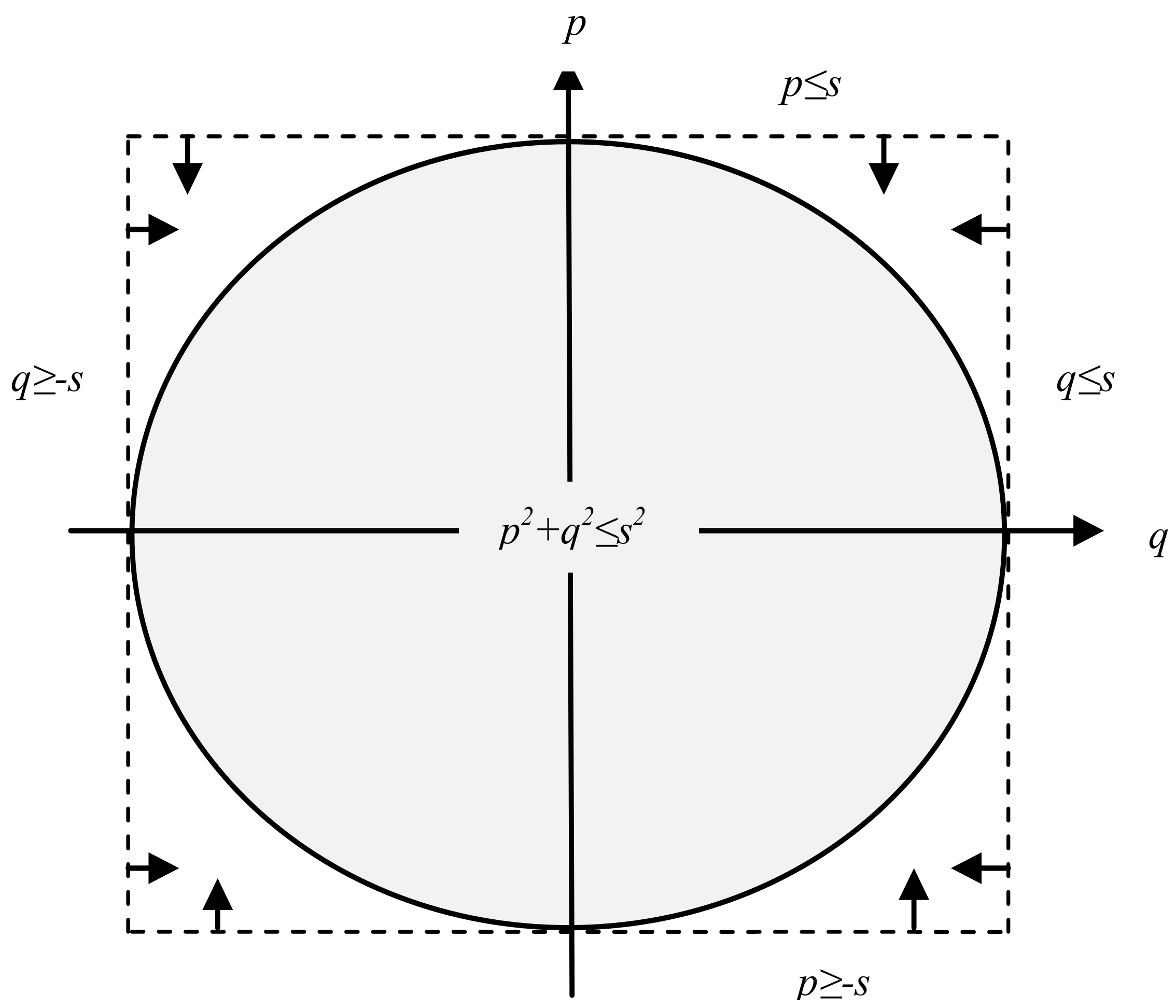
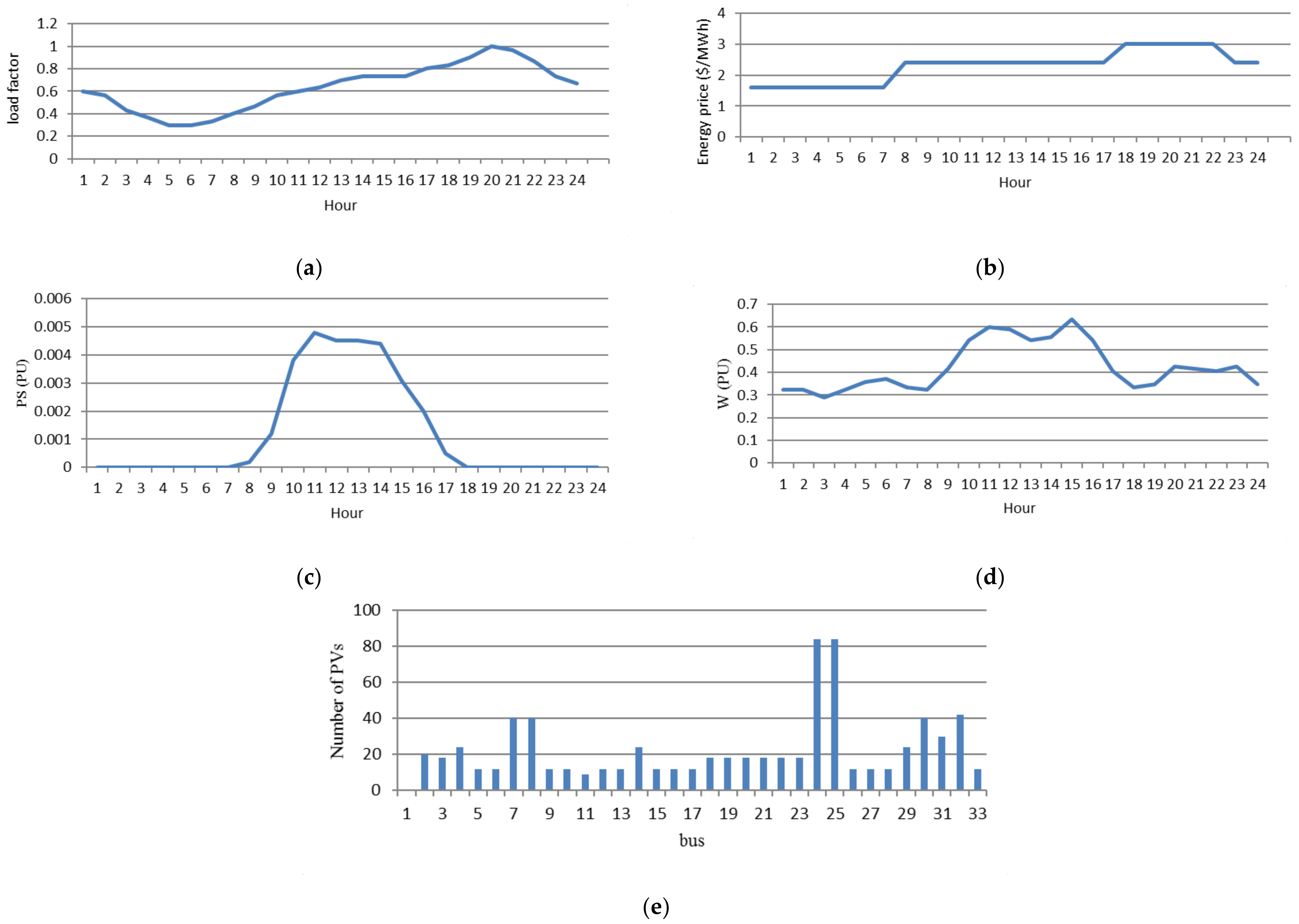
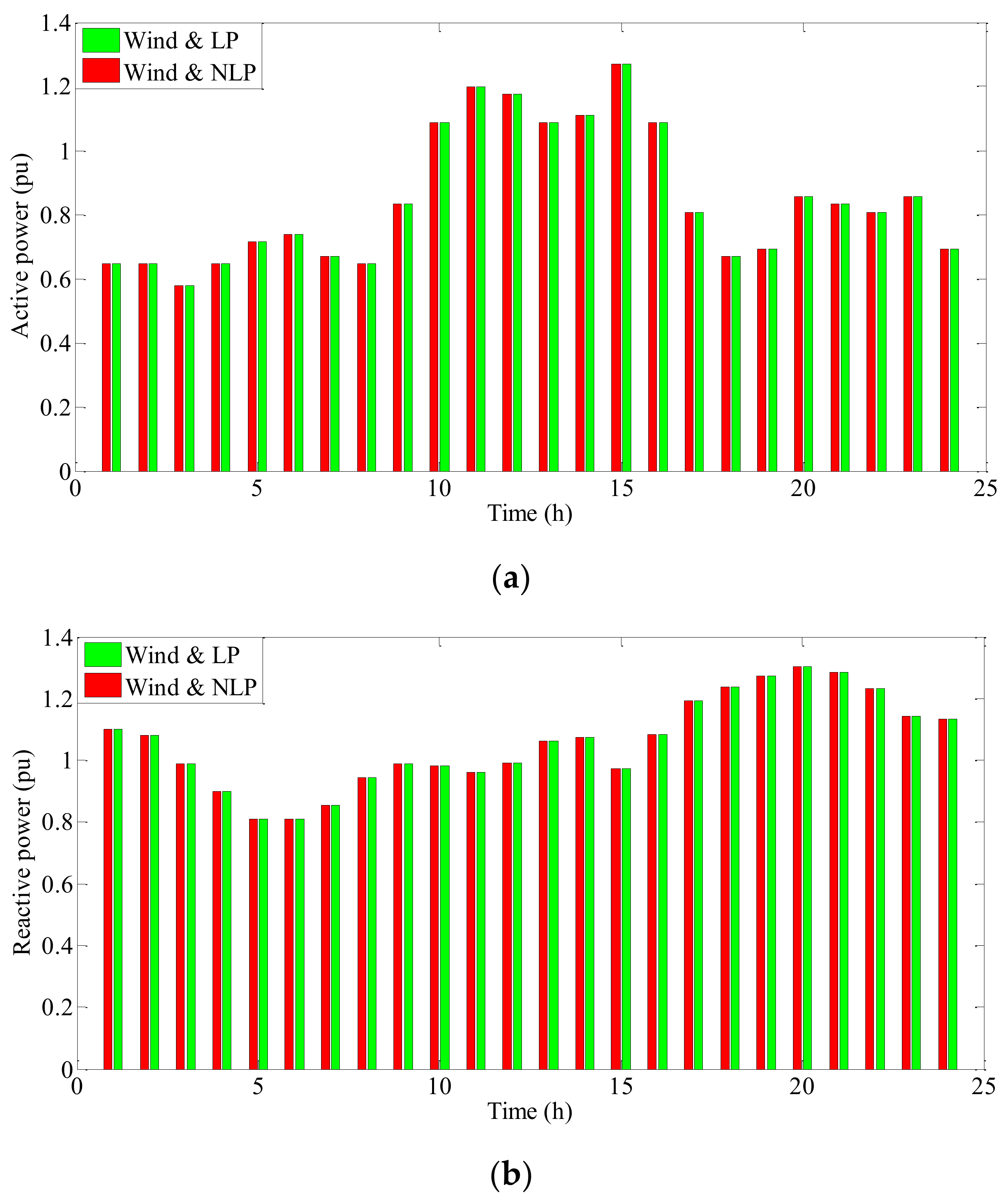
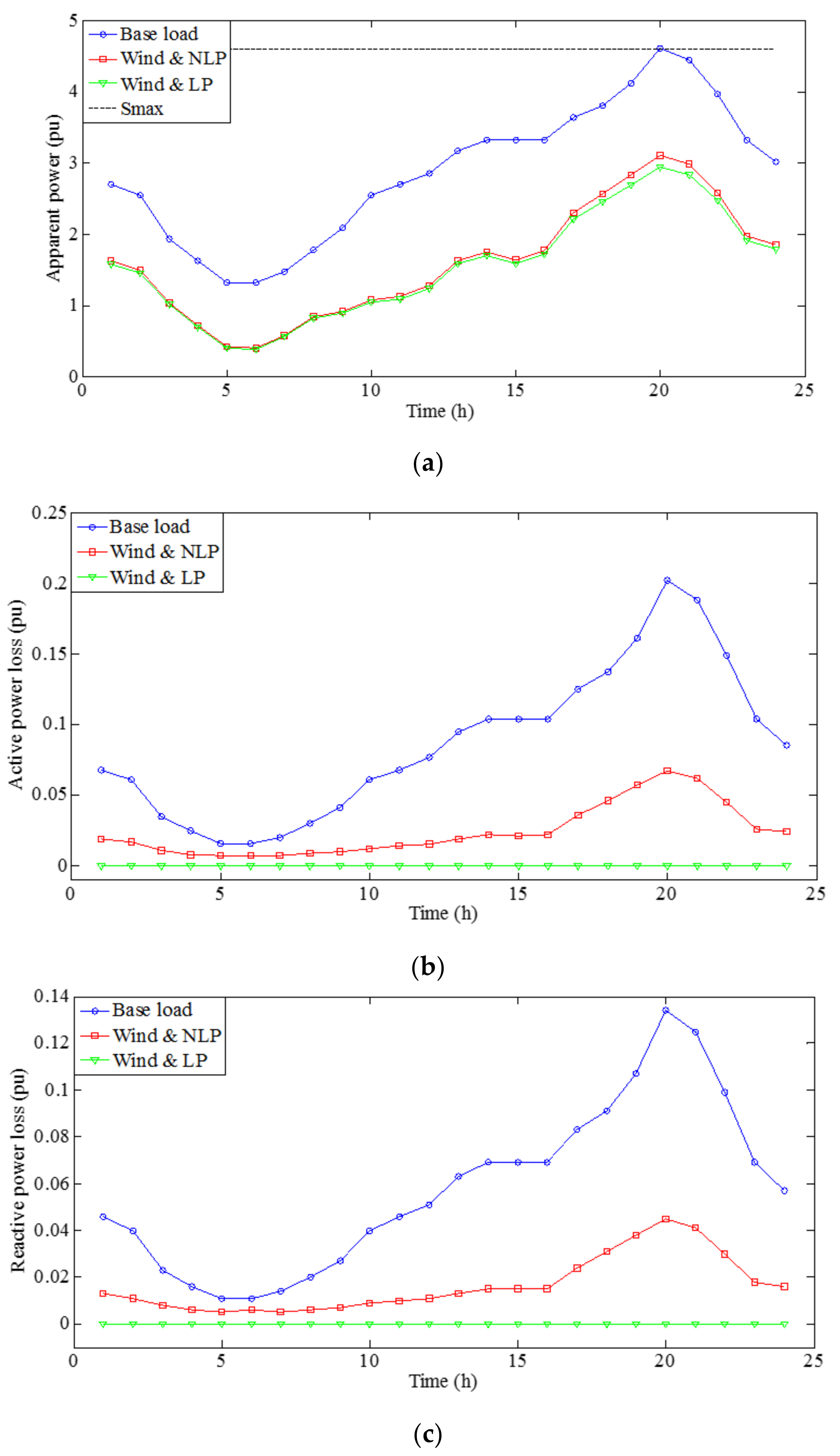
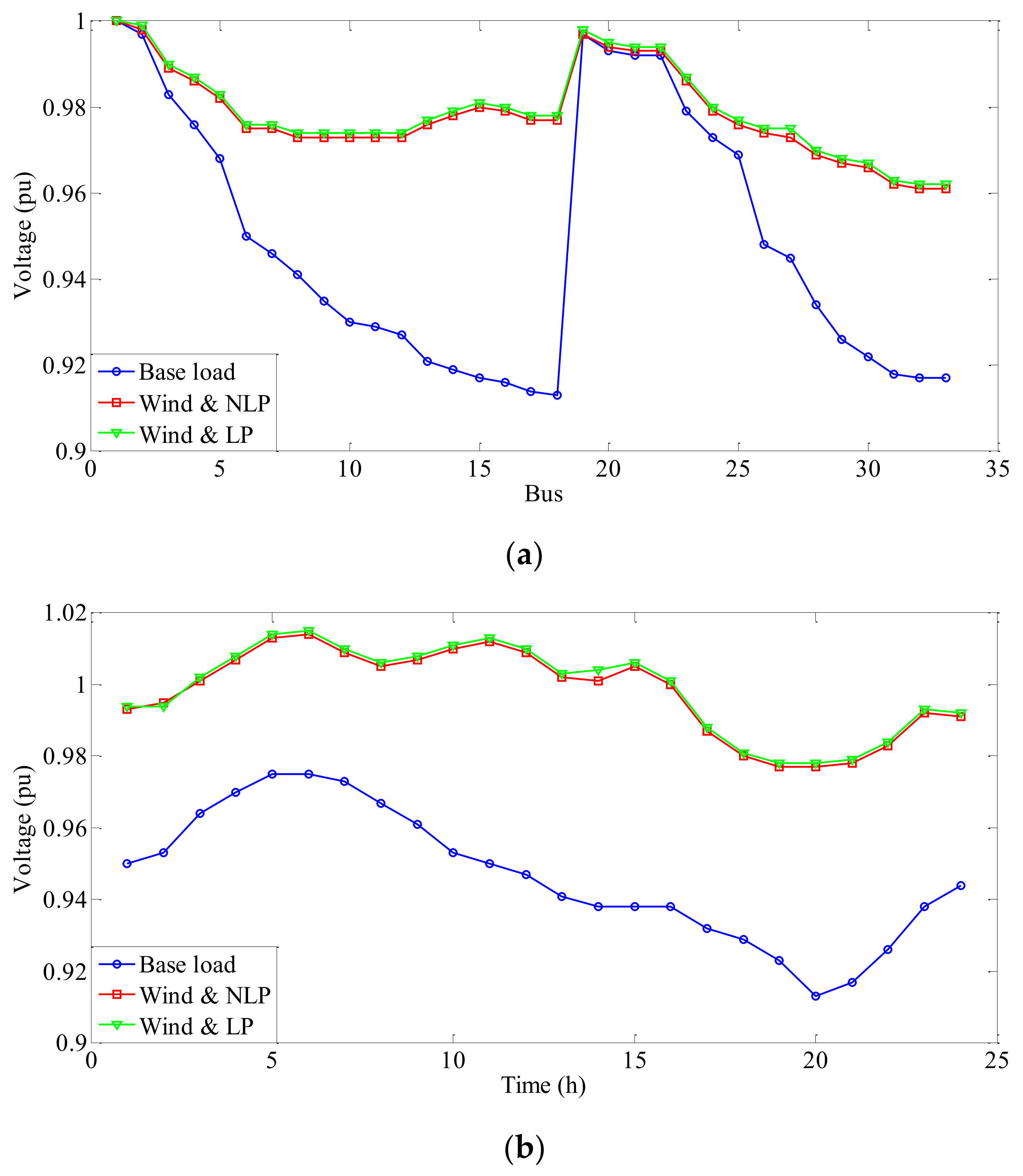
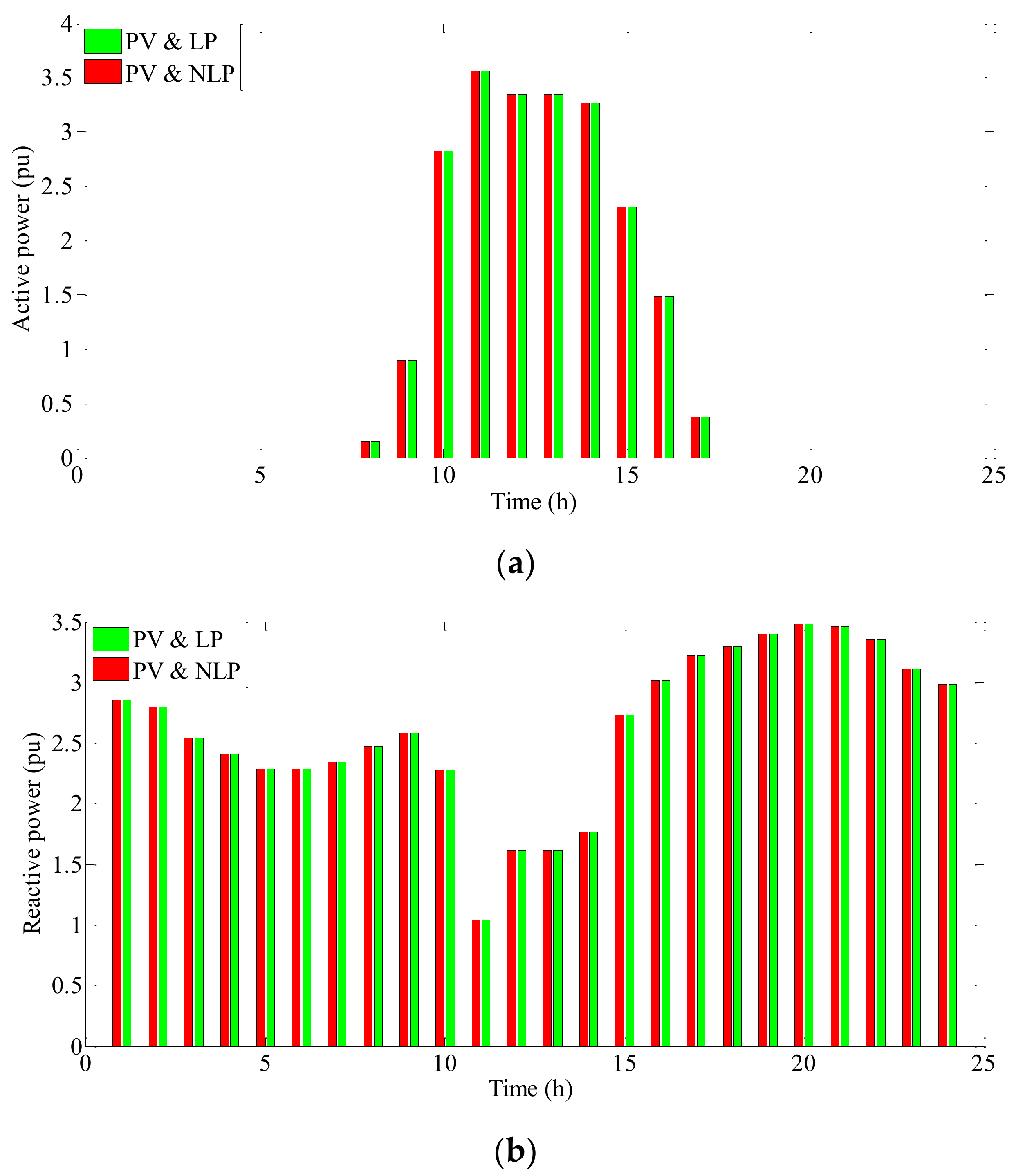
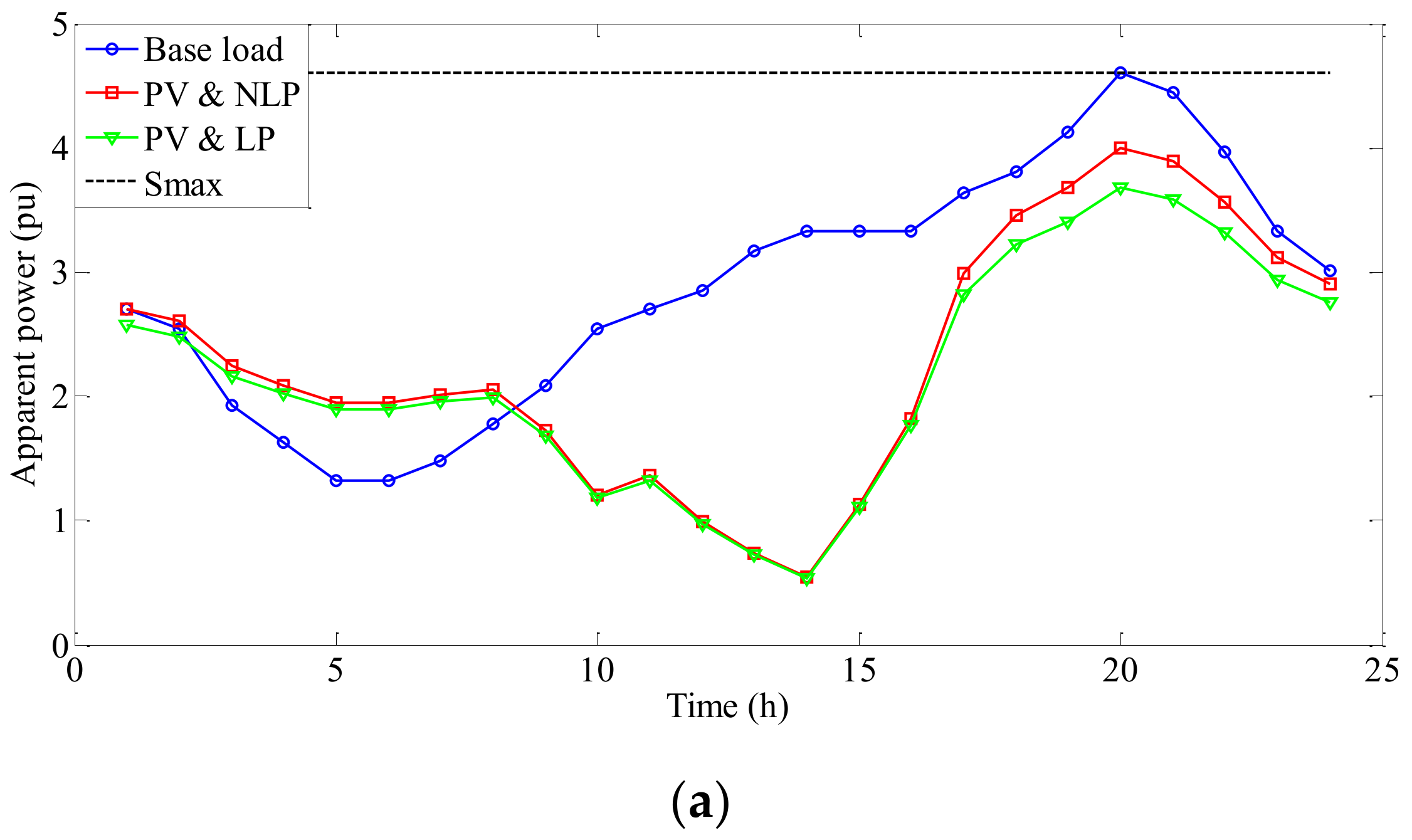
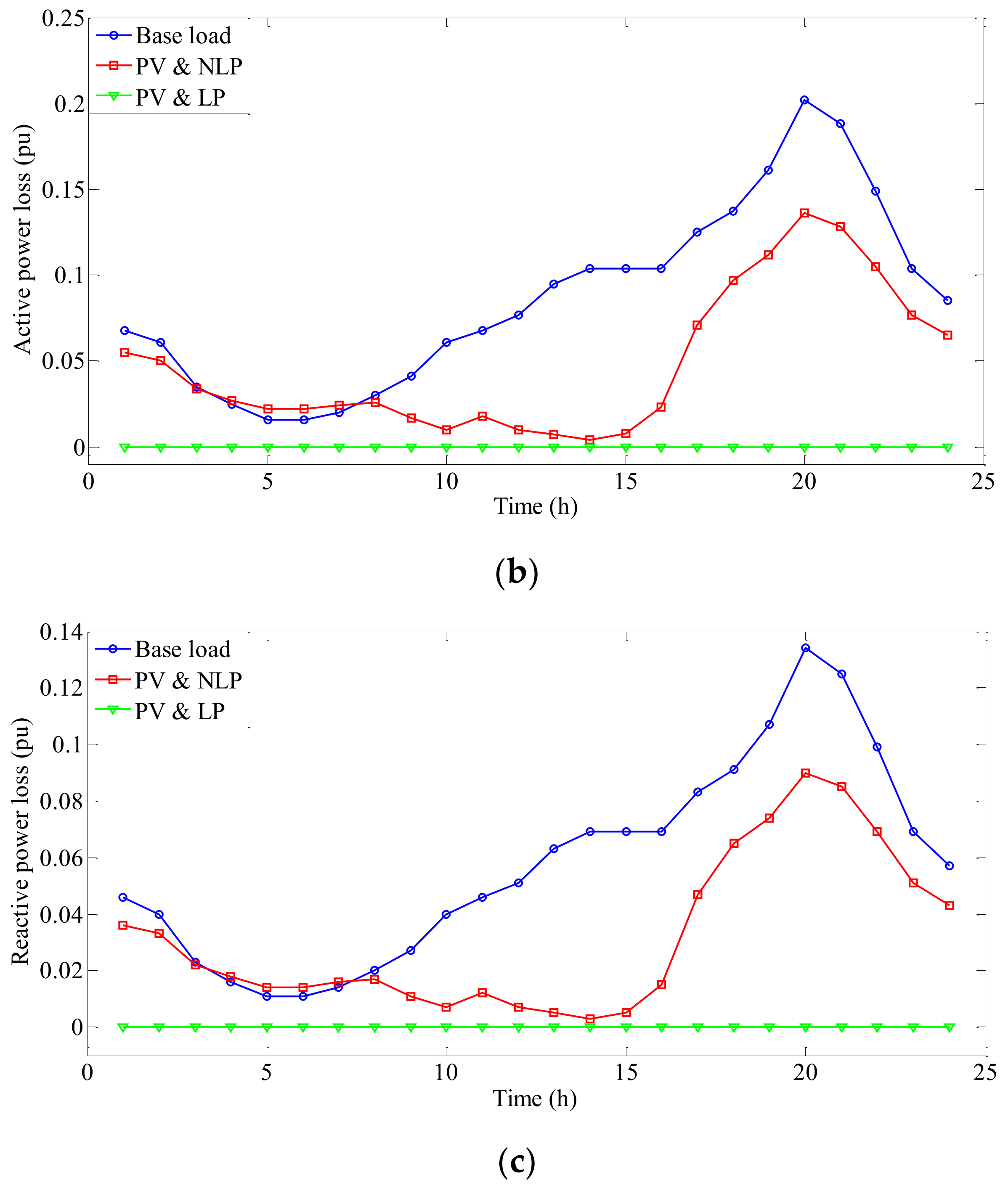
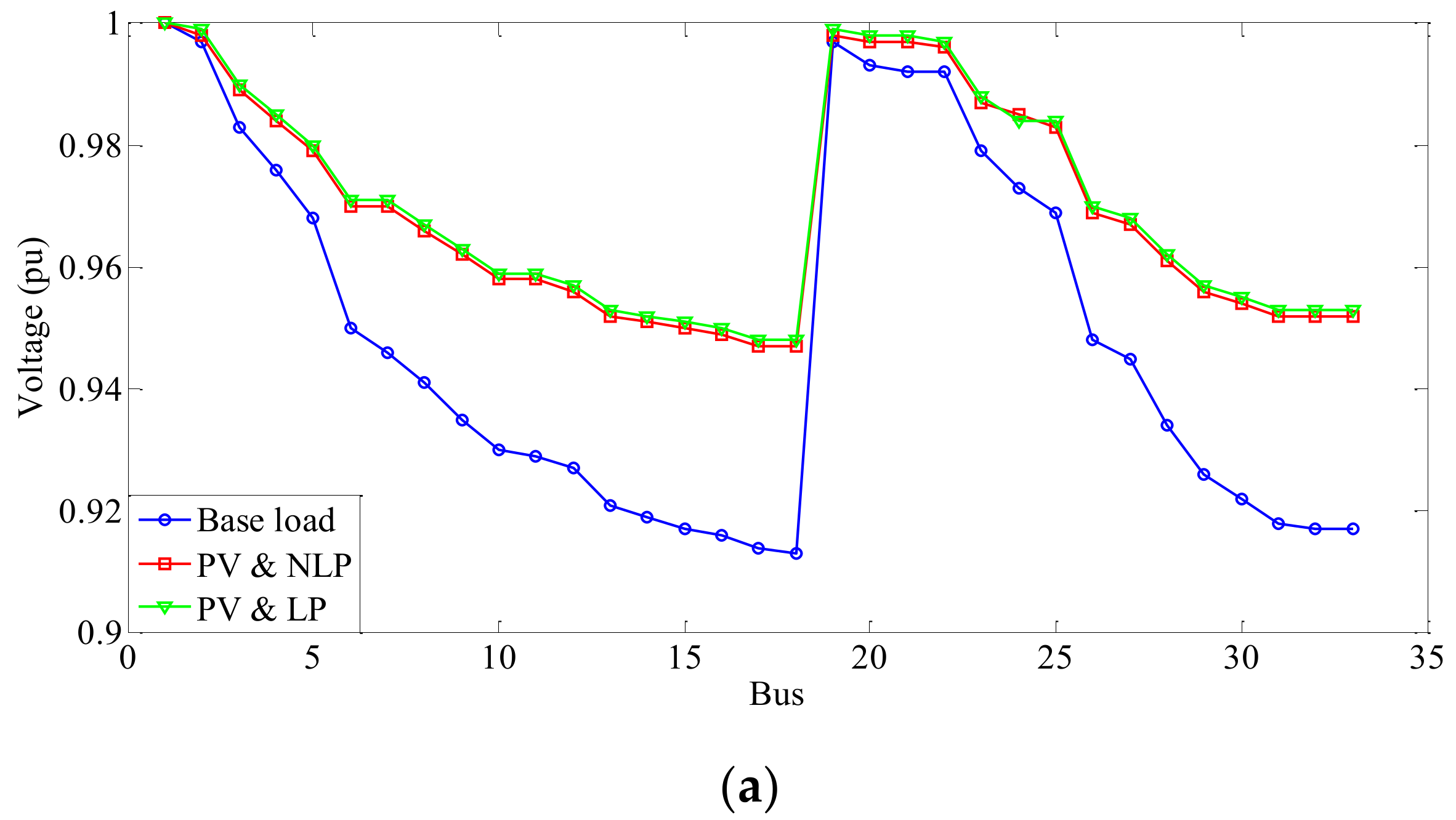
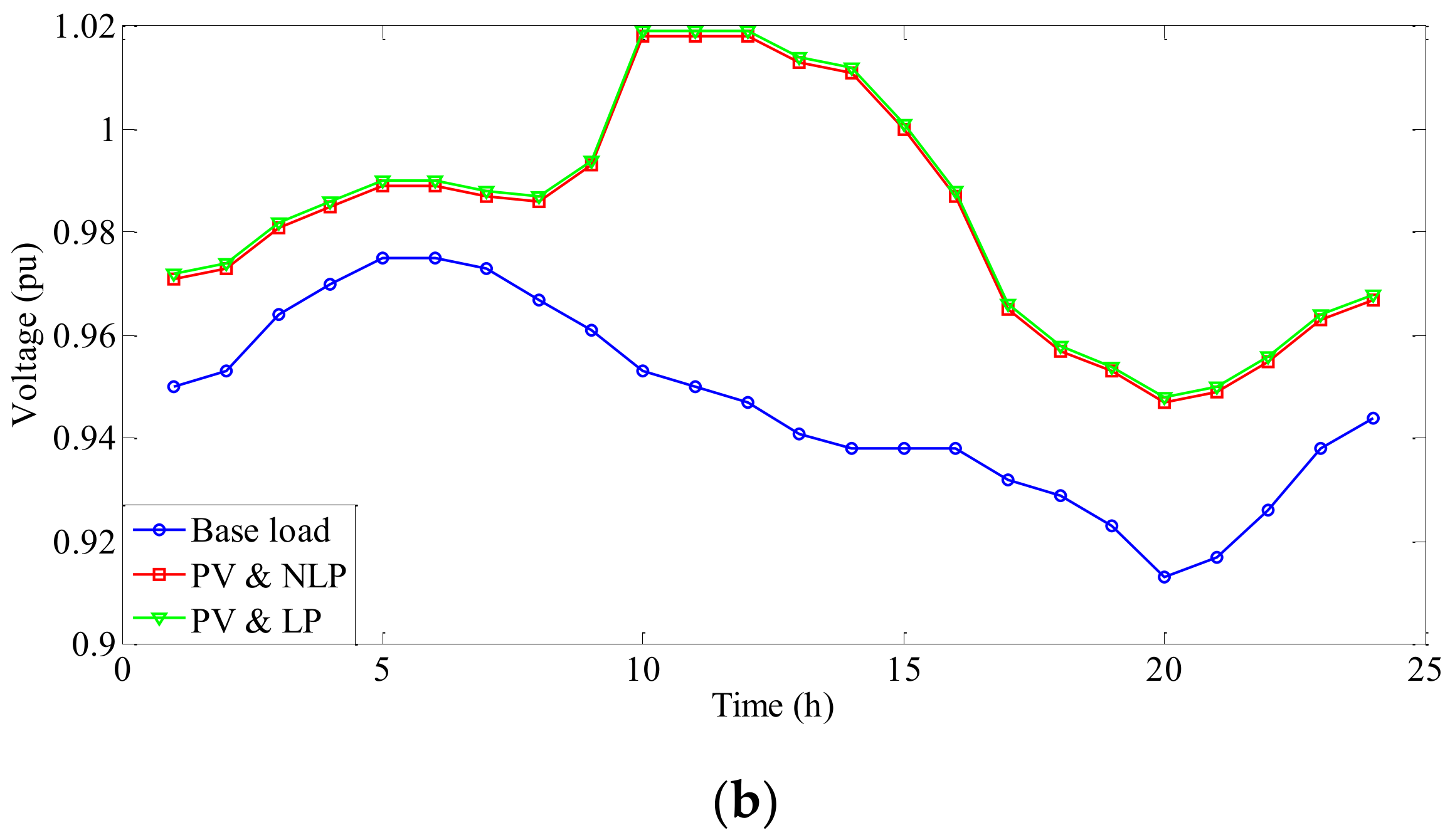
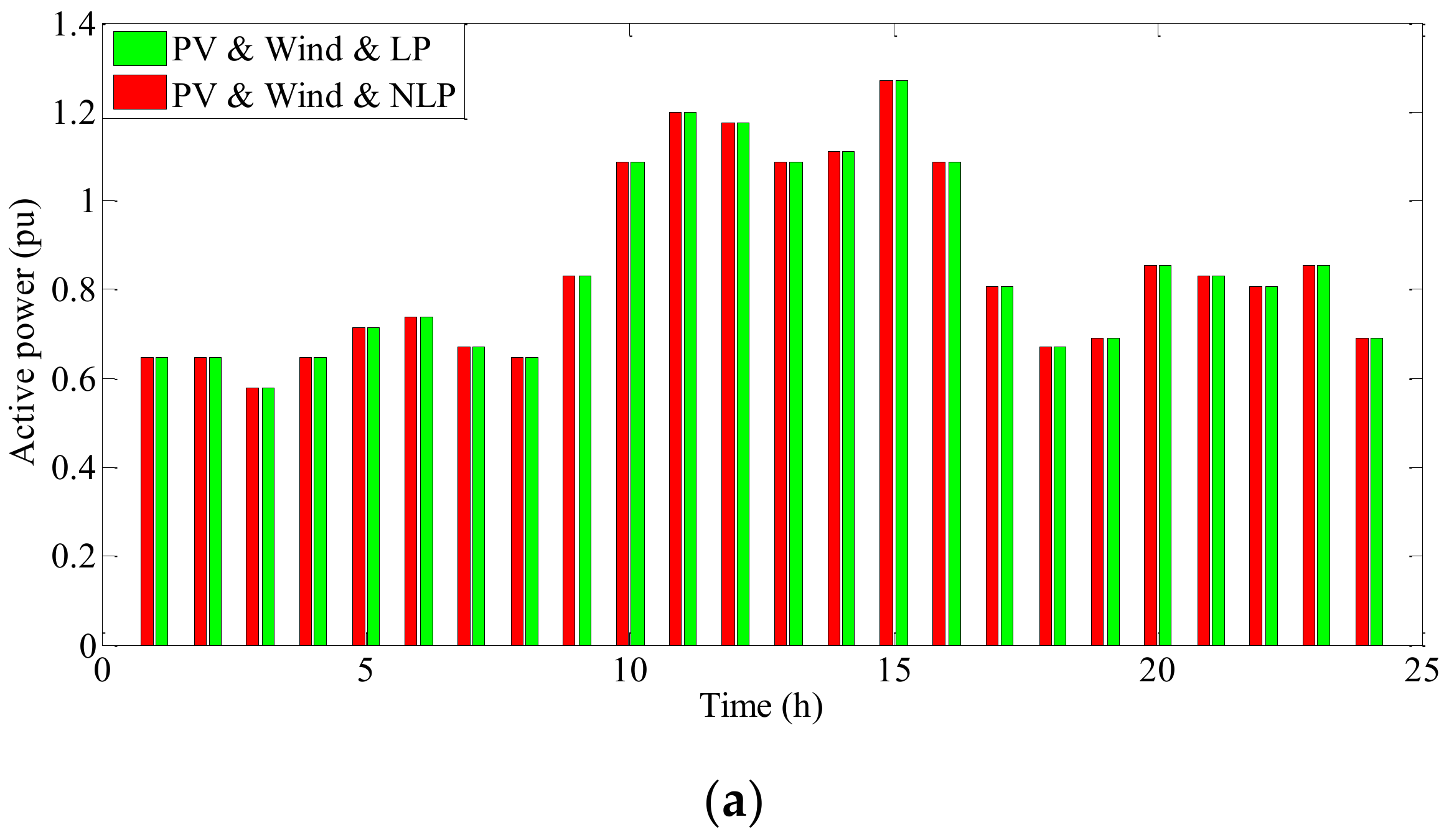
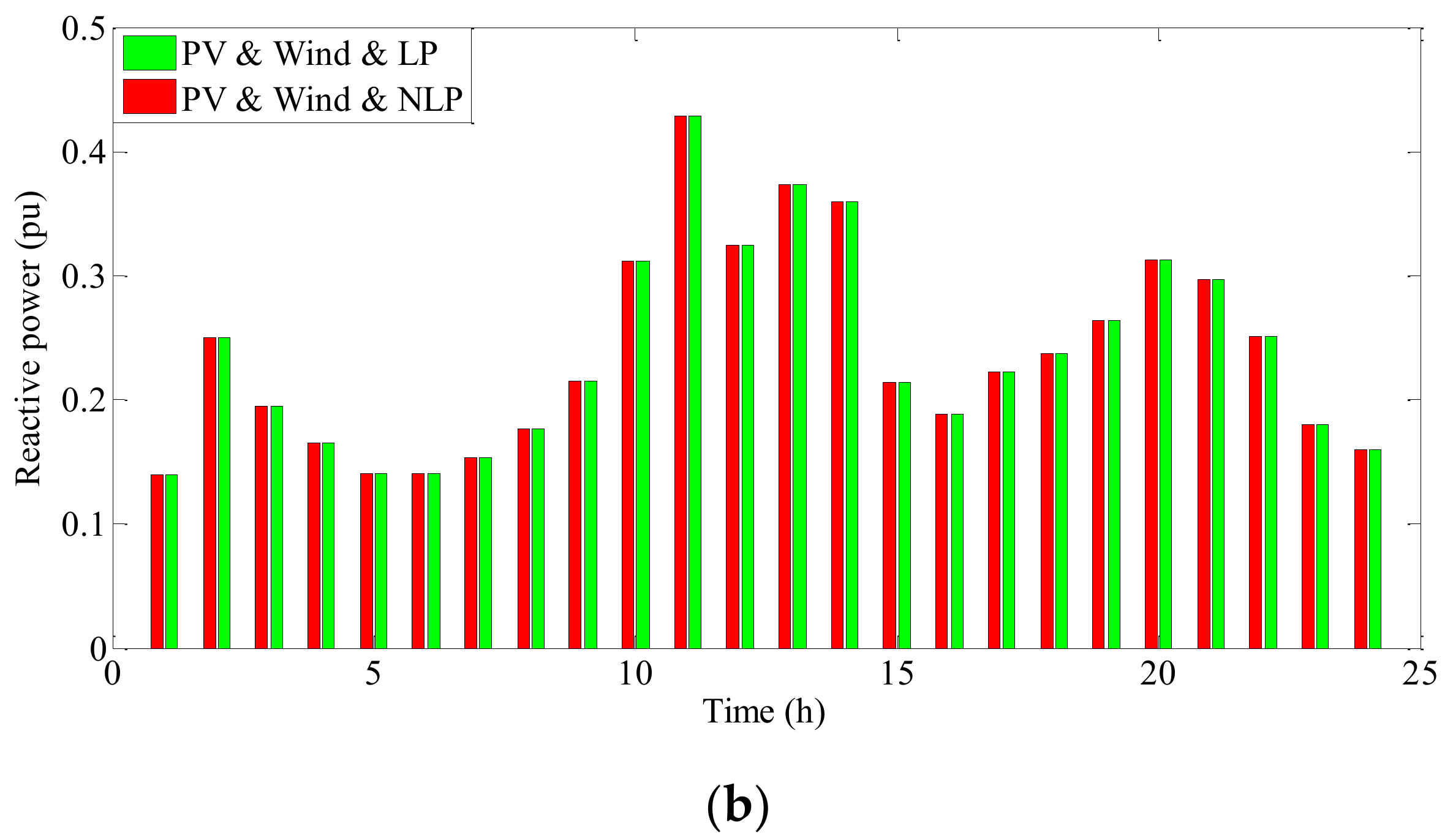
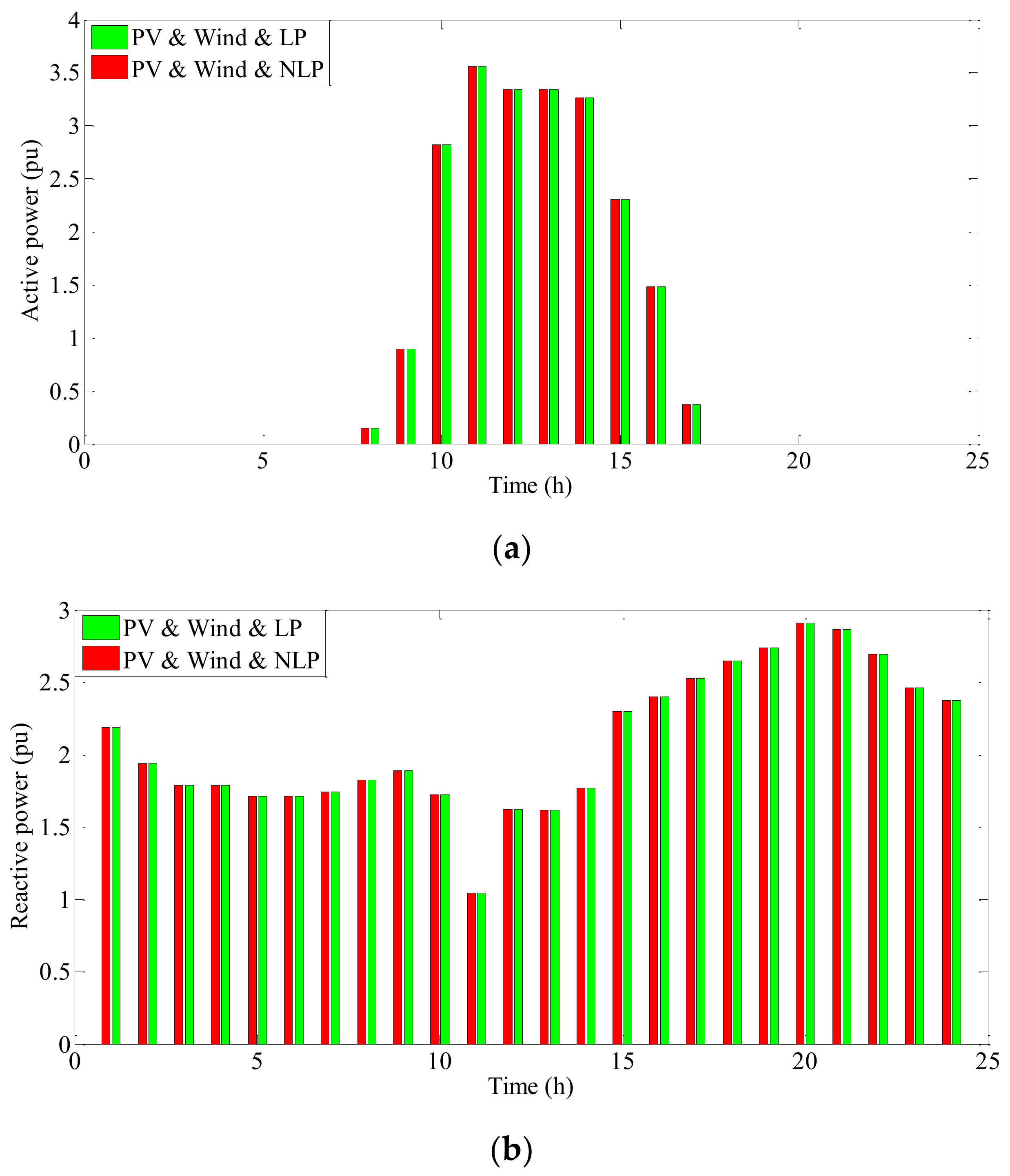
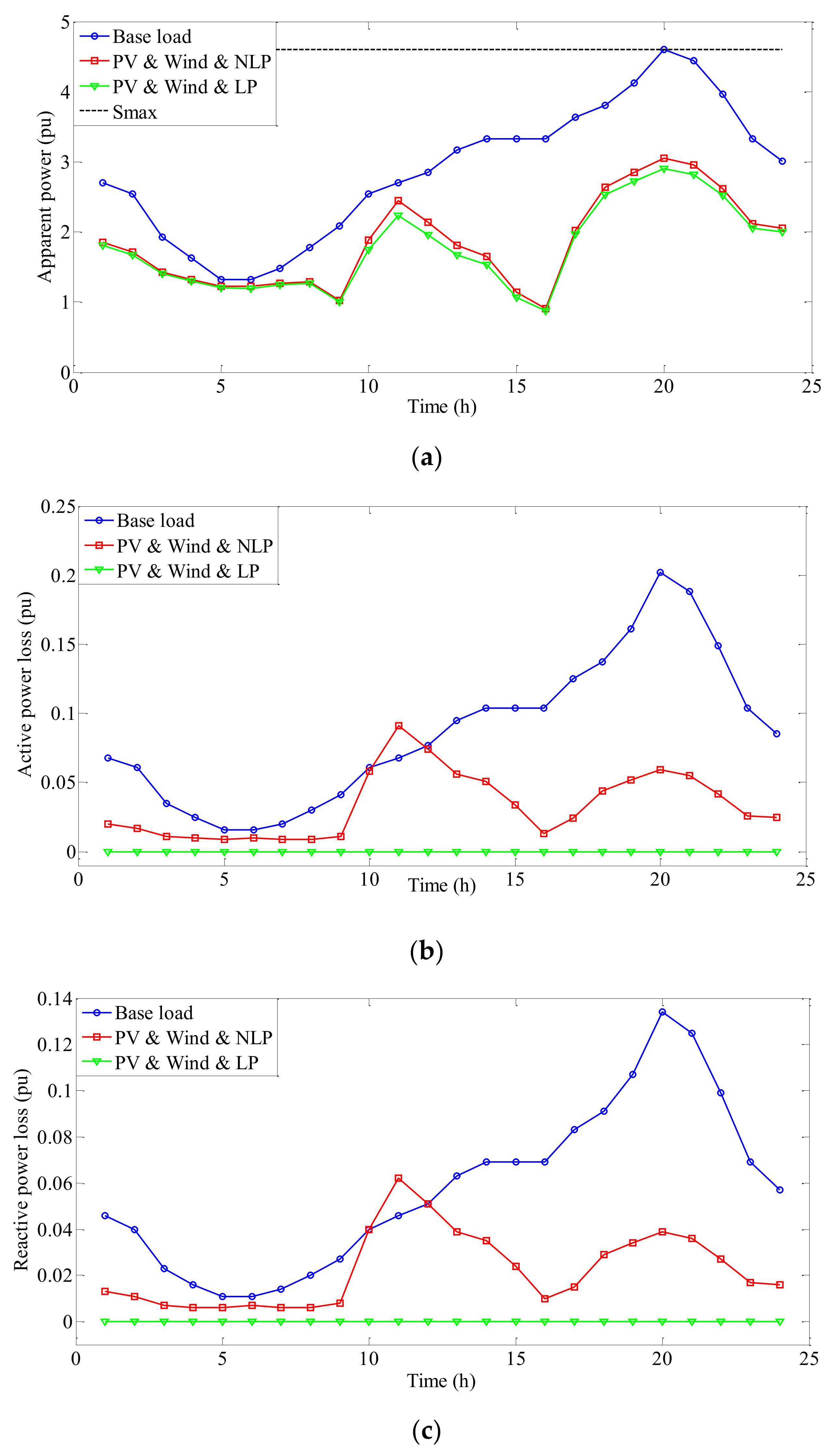
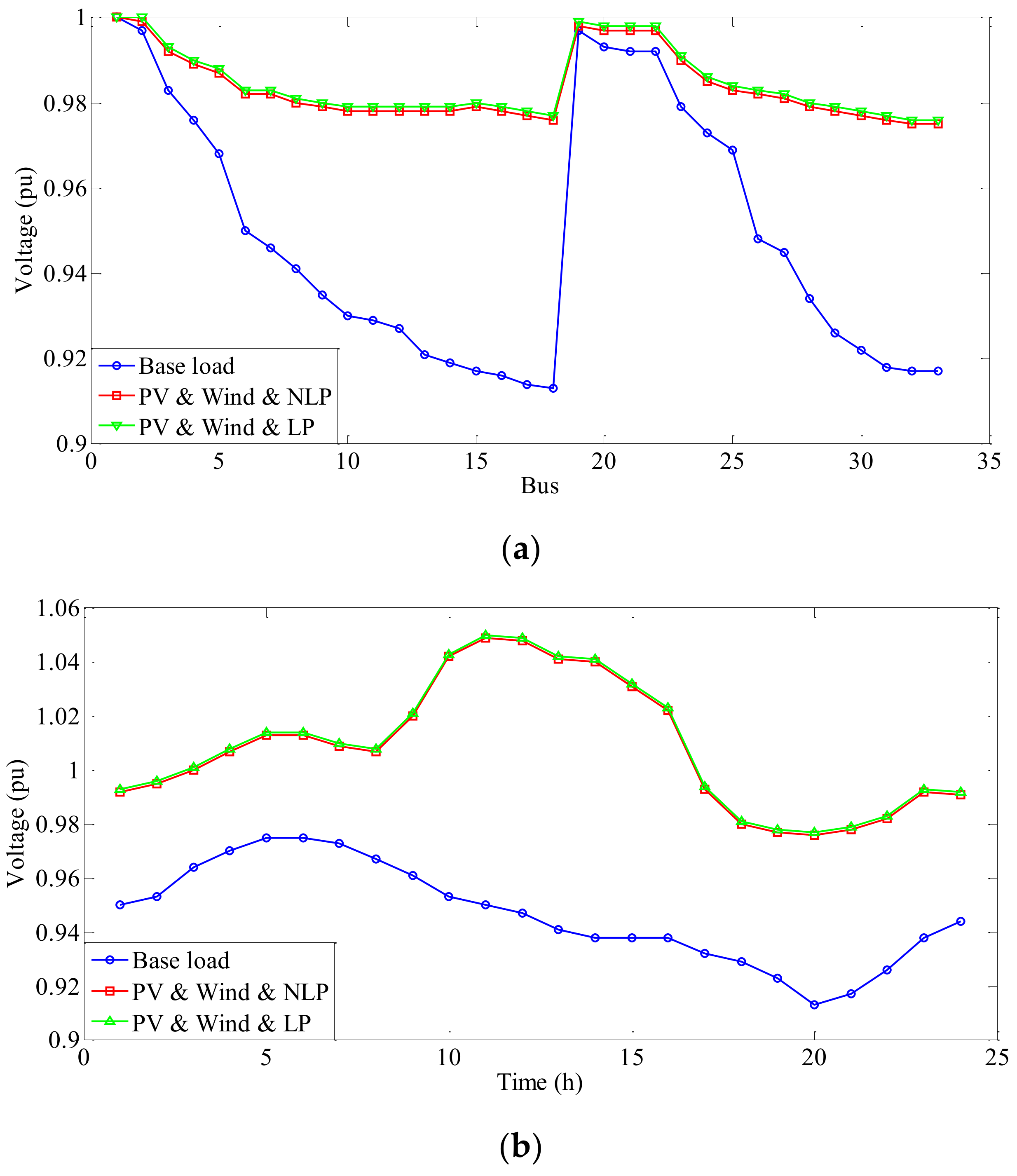
| Parameter | Power Loss (p.u.) at Hour 20:00 | Energy Cost ($) | Maximum Voltage Deviation (p.u.) | Calculation Time (s) | ||||||||
|---|---|---|---|---|---|---|---|---|---|---|---|---|
| Active | Reactive | |||||||||||
| Model | LP | NLP | LP | NLP | LP | NLP | LP | NLP | LP | NLP | ||
| Uncertainty Model | UT | UT | SBSP | UT | SBSP | |||||||
| SDN without renewable penetration | 0 | 0.221 | 0 | 0.130 | 3197 | 3225 | 0.0866 | 0.087 | 0.3 | 0.51 | 35 | 52 |
| SDN with WS penetration (without reactive power control) | 0 | 0.178 | 0 | 0.121 | 2438 | 2465 | 0.0546 | 0.054 | 1.28 | 1.61 | 125 | 159 |
| SDN with WS penetration (with reactive power control) | 0 | 0.135 | 0 | 0.96 | 2436 | 2463 | 0.0328 | 0.033 | 1.4 | 1.73 | 145 | 178 |
| SDN with PV penetration (without reactive power control) | 0 | 0.214 | 0 | 0.126 | 2835 | 2862 | 0.0723 | 0.072 | 1.5 | 1.88 | 155 | 190 |
| SDN with PV penetration (with reactive power control) | 0 | 0.206 | 0 | 0.102 | 2832 | 2859 | 0.0457 | 0.046 | 1.6 | 1.97 | 167 | 201 |
| SDN with WS and PV penetration (without reactive power control) | 0 | 0.172 | 0 | 0.119 | 2039 | 2066 | 0.0506 | 0.050 | 1.9 | 2.35 | 203 | 256 |
| SDN with WS and PV (without reactive power control) and fixed capacitor bank penetration | 0 | 0.163 | 0 | 0.112 | 2038 | 2065 | 0.0427 | 0.042 | 2.1 | 2.49 | 211 | 265 |
| SDN with WS and PV (without reactive power control) and switched capacitor bank penetration | 0 | 0.151 | 0 | 0.103 | 2037 | 2064 | 0.0356 | 0.035 | 2.9 | 3.43 | 254 | 302 |
| SDN with WS and PV penetration (with reactive power control) | 0 | 0.131 | 0 | 0.87 | 2037 | 2064 | 0.0218 | 0.022 | 2.1 | 2.54 | 219 | 272 |
Publisher’s Note: MDPI stays neutral with regard to jurisdictional claims in published maps and institutional affiliations. |
© 2022 by the authors. Licensee MDPI, Basel, Switzerland. This article is an open access article distributed under the terms and conditions of the Creative Commons Attribution (CC BY) license (https://creativecommons.org/licenses/by/4.0/).
Share and Cite
Mehbodniya, A.; Paeizi, A.; Rezaie, M.; Azimian, M.; Masrur, H.; Senjyu, T. Active and Reactive Power Management in the Smart Distribution Network Enriched with Wind Turbines and Photovoltaic Systems. Sustainability 2022, 14, 4273. https://doi.org/10.3390/su14074273
Mehbodniya A, Paeizi A, Rezaie M, Azimian M, Masrur H, Senjyu T. Active and Reactive Power Management in the Smart Distribution Network Enriched with Wind Turbines and Photovoltaic Systems. Sustainability. 2022; 14(7):4273. https://doi.org/10.3390/su14074273
Chicago/Turabian StyleMehbodniya, Abolfazl, Ali Paeizi, Mehrdad Rezaie, Mahdi Azimian, Hasan Masrur, and Tomonobu Senjyu. 2022. "Active and Reactive Power Management in the Smart Distribution Network Enriched with Wind Turbines and Photovoltaic Systems" Sustainability 14, no. 7: 4273. https://doi.org/10.3390/su14074273
APA StyleMehbodniya, A., Paeizi, A., Rezaie, M., Azimian, M., Masrur, H., & Senjyu, T. (2022). Active and Reactive Power Management in the Smart Distribution Network Enriched with Wind Turbines and Photovoltaic Systems. Sustainability, 14(7), 4273. https://doi.org/10.3390/su14074273








